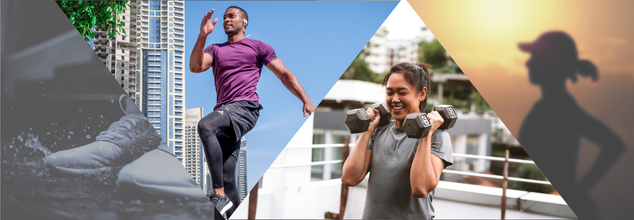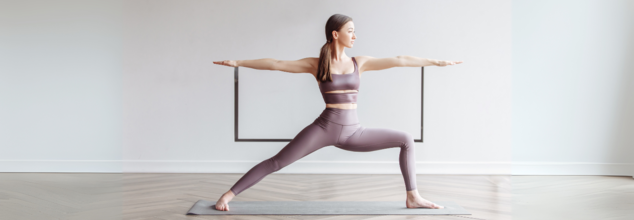- Health Conditions A-Z
- Health & Wellness
- Nutrition
- Fitness
- Health News
- Ayurveda
- Videos
- Medicine A-Z
- Parenting
- Web Stories
Are Abs Really Made In Kitchen? 10 Diet & Exercise Tip For Men

Abs (Credit: Canva)
Getting abs is a dream for all fitness enthusiasts. These well-defined abdominal muscles, visible through the skin, not only enhance a man's aesthetic appeal but also are an indicator of their fitness and health. Achieving these washboard abs typically requires reducing overall body fat, which can be done majorly by being conscious of one's diet and following a proper exercise regime.
Abs Are Made In Kitchen
'Abs are made in the kitchen,' the cliché saying is a cliché because it holds truth. To get perfectly visible abs, one must focus on their diet. Here are top tips for men trying to achieve those 6-pack abs.- Avoid refined and processed foods wherever possible.
- Try to eat six times a day – around every three hours.
- With every meal, use a portion of protein as your base. Think eggs, fish, chicken, and other lean meats.
- Between meals snack on nuts, seeds, avocado, olives, or small bags of snap peas.
- For breakfast and your second meal, make sure you get some starchy carbs – oatmeal, rye, or sprouted bread – and a piece of fruit.
- For lunch, sweet or regular potato, brown rice and quinoa are all excellent options.
- For your evening meal, try to get some veg – but avoid root veg and any starchy carbs.
- Drink lots of water.
- Every 10 days give yourself one cheat meal. It can be anything you want. This might seem strict, but if you’re trying to reveal your abs as quickly as possible such gastronomic sacrifices are necessary.
- Consume one of these post-workout shakes as soon as possible after your workout. Aim for around 40-50g carbs and 20-30g protein. This helps to kickstart the recovery process.
Workout Guide To Get Six Pack Abs
Besides following a well-balanced diet, it is important to focus on the exercises you are doing.
1. Overhead Squats
This exercise engages multiple joints, creating a high metabolic output. It strengthens the midsection as you stabilize the weight overhead while lengthening the core.
How To Do:
Start by grabbing a barbell with palms facing down, positioning your hands near the ends of the bar. Lift it to your chest, then press it overhead, locking your arms while retracting your shoulders. Keep your arms straight, push your hips back, and bend your knees to lower until your thighs are parallel to the ground. Drive through your heels to return explosively to the starting position.
2. Prone Knee to Opposite ElbowThis move stabilizes the midsection similarly to a plank, adding internal hip rotation to target obliques and mobilize hip flexors.
How To Do:
Begin in a push-up position and rotate your right knee towards your left elbow, keeping your hips down and foot off the floor. Alternate legs to complete one rep.
3. Prone Knee to Outside Same Elbow
Similar benefits as the previous exercise, focusing on oblique engagement.How To Do: From a push-up position, lift your right knee towards your right elbow, aiming to touch it. Alternate legs for each rep.
4. Push-Ups
Push-ups enhance midsection stability while targeting the chest, shoulders, and triceps.How To Do: Perform as many standard push-ups as possible. If you tire, switch to knee push-ups to complete 15 reps.
5. Swiss Ball Hamstring CurlsThis exercise targets the posterior chain, strengthening the hamstrings and glutes.
How To Do: Lie on your back with a Swiss ball under your heels. Keep your hips elevated and curl your heels towards your glutes, then return to the starting position.
6. Split Lunge with Overhead Press
This movement activates the midsection while incorporating a high metabolic output through multiple joint use.
How To Do: Hold a dumbbell on each shoulder in a lunge position. Lower your back knee to the floor and press the dumbbells overhead as you lunge.
7. Cardio Finish: Uphill Treadmill Walking
After completing three circuits of the previous six exercises, hit the treadmill for additional cardio.Walking on an incline burns extra calories after depleting glycogen stores, helping to preserve muscle tissue.
How To Do: Set a challenging incline and walk briskly. Avoid running to reduce stress on fatigued muscles.
Fat Loss And Strength Gaining Made Easier With This Change In Workout Order

(Credit-Canva)
Should you do cardio or weights first? All gym goers have been faced with this choice one too many times. Some prefer doing weights before they hit the cardio machines, while others try to get over it before. But is there a better option of the two?
New research suggests you might want to hit the weight room before you hop on the treadmill, bike, or elliptical.
A study published in April in the Journal of Exercise Science and Fitness investigated how the order of cardio and resistance training might impact health and fitness. The findings showed that participants who did strength training before cardio had "remarkable progress" in physical activity, fat loss, and muscular strength and endurance.
But does this mean lifting weights before cardio is always the optimal choice?
What Happens When You Do Cardio After Weights, and Vice Versa?
In the study, researchers had a group of young men who were overweight or obese try different workout orders. They split the men into three groups:
- One group lifted weights, then did cardio.
- Another group did cardio, then lifted weights.
- The third group didn't do any structured exercise.
The groups that exercised worked out three times a week for an hour each session, over three months. Both exercise groups did 30 minutes of cardio and 30 minutes of strength training; only the order was different. Experts noted that a good point of the study was that both groups followed the same workout plan, which helped keep things fair.
Before, during, and after the study, researchers checked everyone's activity levels, body fat, muscle strength, and heart fitness. The results showed that both exercise groups improved in:
- How active they were
- Their body composition (less fat, more muscle)
- Muscle strength
- Heart and lung fitness
These results suggest that lifting weights before cardio is the best if you want to improve these specific things. However, a point noted was that the group that did cardio first still saw "very good" improvements that are good for health.
How Your Workout Order Affects Your Body
Generally, the order of your workout matters because of how each type of exercise makes you tired. Doing cardio first can make you tired, meaning you might not have enough energy to put your full effort into lifting weights. Research supports this, showing that intense cardio before weights can reduce your strength endurance.
When you lift weights first, you're likely able to do your strength training with your best energy and focus. This might explain why the group that lifted weights first in the study spent more time training at higher intensities. This order could be ideal for people looking to build muscle or lose weight.
However, doing cardio before lifting weights also has benefits, especially if you're trying to improve your cardio endurance and heart and lung health. It allows you to put your best effort into your cardio sessions, which can be helpful if that's something you struggle with.
Building the Best Workout Routine for You
When planning your workouts, think about your main goals. Start with whichever type of exercise—strength or cardio—you want to prioritize and improve the most. Just make sure you don't skip either type of training. Both are important for improving your health and fitness and should be a regular part of your exercise routine.
Also, changing up your workout order occasionally can help your body adapt to new challenges, further improving both muscle and heart fitness. Ultimately, remember that simply doing either cardio or weight training will help you improve muscle strength, bone density, heart endurance, and fat loss.
Most people prefer to lift weights followed by cardio, and more studies support the benefits of this order. But the most important thing is to find what works for you, and the health benefits will follow.
UK-based Reporter Tried The One Exercise Loved By Meghan Markle, Kardashians, And Hailey Bieber - Here's How It Went For Her

Credits: Wikimedia Commons and Instagram
Lagree Pilates has fast become the go-to workout for Hollywood A-listers, drawing the likes of Meghan Markle, Kim and Khloe Kardashian, and Hailey Bieber. Touted as a game-changer in strength and endurance training, Lagree combines elements of traditional Pilates with high-intensity, low-impact resistance exercises. Unlike the more familiar Reformer bed used in standard Pilates, Lagree is performed on a Megaformer—a machine specifically designed to target core strength, muscular endurance, balance, and flexibility all at once.
While the Megaformer has yet to become mainstream across all UK cities, Re:Sculpt studios in Manchester’s Ancoats and Salford offer a close alternative: the Maxformer, reports the Express UK. These machines mimic the design and intensity of Lagree’s original equipment, and their popularity is catching on quickly among fitness enthusiasts.
The Workout: More Sweat, Less Impact
Lagree Pilates sets itself apart by fusing strength training with cardio and balance-focused movements in a continuous flow, meaning minimal rest and maximum burn. It's often described as the “next level” of Pilates—great for building lean muscle, especially in the core, with little strain on joints. This makes it appealing not just for aesthetics but also for sustainable, long-term fitness.
The Experience: Pushing Past Limits
Isobel Pankhurst, a reporter with Express UK, decided to try the Maxformer class at Re:Sculpt’s Ancoats studio. Despite being no stranger to Reformer Pilates, she approached the session with caution. Upon arrival, she was greeted with a motivational quote—“So tough, but unreal!”—and a glass of citrus electrolytes, a detail that immediately made her second-guess her decision. After all, she’d never been handed electrolytes before a workout. What exactly was she in for?
The class, called Re:Tread, merges two formats: half the time on the Maxformer bed, and the other half on a treadmill. Each day alternates between focusing on upper or lower body, and Pankhurst’s visit landed her in an upper-body session.
The Maxformer, she quickly discovered, was not just a souped-up Reformer. It demanded far more in terms of strength and balance. The moves challenged her core and coordination, and even with prior Pilates experience, she found herself struggling. That said, the intensity also brought satisfaction. “It was so much more difficult than a Reformer,” she admitted, “but I did enjoy trying it out and will definitely return.”
The Treadmill Trials
After 20 sweat-drenched minutes on the Maxformer, the second half of the session moved to the treadmill. As someone who rarely runs—unless late for a train—Pankhurst dreaded this portion. “I’m not a fast runner,” she confessed, keeping her settings at a gentle jog while others sprinted full force. Still, she viewed it as a step above lazing in front of the TV and pushed through.
The Aftermath: Sore, but Satisfied
By the end of the hour-long session, she was wiped out and ready for a shower, but not before grabbing a protein shake to help recover. The next day came with the expected soreness, but also a sense of accomplishment. “It was tough,” she said, “but worth it. That quote of the month really was spot-on.”
So while the Maxformer may not be for the faint of heart, it’s certainly a full-body challenge worth considering—especially if you’re curious about what keeps Meghan and the Kardashians in shape.
8 Balancing Yoga Poses That Can Help You Build Your Co-Ordination And Flexibility

Many people falsely believe yoga poses are just meant to make you comfortable and flexible, they think it is something one only needs to do if they wish to calm down. However, it is so much more than that. If done properly, it can change the way you live life. Whether it is making yourself more balanced, more flexible, losing weight, or being stronger.
Yoga is way more than just stretching. It's a powerful way to bring your mind and body closer, offering real benefits that can change your everyday life. If you want to get healthier, calm your thoughts, or just feel more connected to yourself, yoga gives you a full-picture way to feel good. It can make you stronger, more flexible, and more balanced, all while helping you handle stress and boost your overall mood.
Why Balancing Yoga Poses?
Balancing yoga poses do much more than just challenge your stability; they actively improve your overall health and well-being. These powerful poses work wonders by making your body stronger and more stable, especially in your core, legs, and ankles.
Balancing yoga poses also sharpen your mind. You'll notice better focus and less stress as you learn to center yourself in each pose. By always adjusting to stay steady, you become much more aware of your body's position. This leads to smoother movements and fewer stumbles in your daily life. Basically, balancing yoga helps you become stronger, more coordinated, and more aware of yourself.
Eagle Pose
This pose challenges your balance by wrapping one leg around the other and crossing your arms. It deeply stretches your shoulders and upper back while strengthening your core for better stability.
Extended Hand-to-Big-Toe Pose
Standing on one leg, you extend the other forward, holding your big toe. This pose significantly improves your hamstring flexibility and core strength, while challenging your standing leg's stability and enhancing mental concentration for better balance.
Half Moon Pose
From a standing position, you extend one arm and the opposite leg out to the sides, forming a "T" shape. This pose beautifully opens the hips and chest, strengthens the core, and dramatically improves your sense of balance and spatial awareness.
Handstand
Practiced against a wall or free-standing, this inversion builds immense upper body and core strength. It demands intense focus and body awareness, fundamentally improving your balance by challenging your perception of alignment and stability upside down.
Lord of the Dance Pose
Standing on one leg, you reach back to grasp the foot of your lifted leg, extending it upwards like an archer's bow. This deep backbend and hip opener demands significant balance and concentration, while also increasing spinal flexibility and leg strength.
Side-Plank Pose
Supported on one hand and the side of one foot, your body forms a straight line. This powerful pose deeply strengthens your core, obliques, and arms. It's a fantastic way to build stability through your entire side body, crucial for coordination.
Side-Reclining Leg Life
Lying on your side, you lift your top leg straight up towards the ceiling. While seemingly simple, this pose strengthens your outer hip and thigh muscles, crucial for walking stability and balance. It gently improves flexibility without high impact.
Warrior 3 Pose
Standing on one leg, you extend your torso forward and the other leg straight back, forming a "T" shape parallel to the floor. This dynamic pose strengthens your entire leg and core, while intensely challenging your balance and building focused determination.
© 2024 Bennett, Coleman & Company Limited

